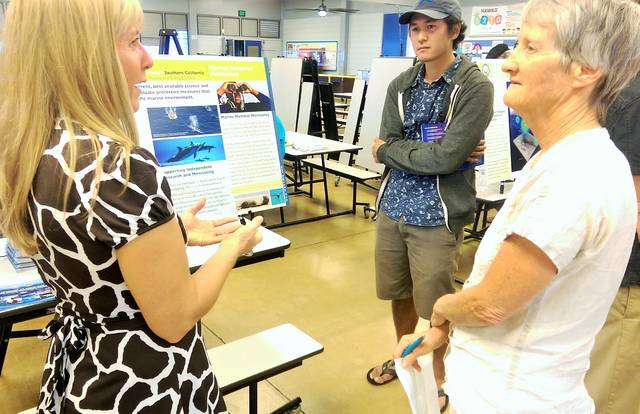HILO — Despite Navy assurances that the military is using the latest science to protect marine mammals during bombing and sonar training exercises, most of the approximately 75 people attending a public meeting Thursday evening remained skeptical. ADVERTISING HILO —
HILO — Despite Navy assurances that the military is using the latest science to protect marine mammals during bombing and sonar training exercises, most of the approximately 75 people attending a public meeting Thursday evening remained skeptical.
The meeting, the final of four across the Hawaiian islands, is part of the Navy’s draft environmental impact statement seeking permission from the National Marine Fisheries Service to continue military training activity over the next five years.
Capt. Vinnie Johnson, commanding officer, Pacific Missile Range Facility, said the Navy can remain stewards of the environment and protect marine mammals while conducting tests that are necessary for defense of the nation.
“We can be responsible stewards of natural resources, we can be responsible stewards of cultural resources and we can be responsible stewards of our community,” Johnson said.
Officials said mitigation measures such as trained lookouts aboard ships who halt exercises if marine mammals are seen in the vicinity and extra precautions during humpback whale season keep harm to a minimum.
Fewer than .03 percent of mammals are expected to die from testing, although many more could experience temporary behavioral effects, they said. Disorientation, fleeing the area, or in extreme cases, beaching can occur when the mammals’ activity is impaired by noises from bombing and sonar.
Johnson said the Navy was not testing prior to a beaching last month of pilot whales on Kauai, which resulted in five whale deaths. National Oceanic and Atmospheric Administration scientists are still investigating.
Members of the public, bringing their messages through speeches, on paper, through oli and even in song, weren’t buying it. Impassioned speeches urged the military to clean up areas it’s already polluted before continuing bombing practices.
“It is a shibai. It is a drama, a procedure they force you to go through,” said Ronald Fujiyoshi. “But it doesn’t make any difference because they will do what they intended to do in the first place.”
“The U.S. is already the most warring nation on the planet,” said Nelson Ho. “They already control the largest military theater on the planet — the Pacific Ocean.”
Earl DeLeon, who in the past has stood for Aloha Aina on Kahoolawe, spoke of his experiences when the military used it as a bombing range.
“We wen stop them on Kahoolawe, but they come to Pohakuloa … (and) to the ocean,” DeLeon said. “The pollution, the desecration, it has to stop. It has to stop.”
Others beseeched the Navy on behalf of the whales and dolphins.
“We live amongst these cetaceans in a marine mammal sanctuary,” said Jan Salerno, who traveled from Kona to address the Navy. “No collateral damage is appropriate.”
“Any amount of sonar and explosives in our ocean is not acceptable,” said County Councilwoman Jen Ruggles, who represents Puna.
Some speakers put the Navy on notice that the Hawaiian Kingdom is seeking redress in international courts to regain control of the islands, and then the U.S. military will not be welcome. Some demanded that the Navy hold consultations with the Native Hawaiian community before moving forward.
Speeches were regularly punctuated by audience remarks and applause.
On Hawaii Island, the EIS would allow the Navy to return to areas carved out of consideration following a lawsuit.
The Navy had agreed to refrain from exercises in sensitive areas in East and West Hawaii Island in a 2015 settlement agreement that came from a lawsuit against Marine Fisheries filed by Earthjustice on behalf of the Conservation Council of Hawaii and other groups, Earthjustice attorney David Henkin said Tuesday. Those areas include the channel between Kona and Maui.
The Navy plans to take special care in those areas, according to its EIS.
The meetings have been well-attended throughout the islands, said Alex Stone, program manager with the U.S. Pacific Fleet. He urged the public to read the EIS and submit comments.
The EIS offers three options: a “no action” alternative, a reduced training alternative and a more intensive training alternative.
The full EIS can be downloaded at https://hstteis.com/Documents/2017-Hawaii-Southern-California-Training-and-Testing-Draft-EIS-OEIS/Draft-EIS-OEIS.
Comments can be submitted by Dec. 12 via methods detailed at https://hstteis.com/Public-Involvement/Public-Comment.



